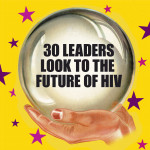Gloom and Glitter
POZ was born into a dark world for PWAs. AIDS deaths were peaking. The Concorde Study had just confirmed that AZT, for years the only HIV med, did nothing to slow the disease. True to the times, many of our first major advertisers were viaticals offering to buy the life insurance of near-death readers. “Too many people are dying broke,” one ad read. “It doesn’t have to be that way.”
Yet despite the despair, a dazzling convergence of politics, media, art, celebrity and PWA activism was transforming AIDS from America’s greatest fear into its most glamorous cause. It was all symbolized by a simple red ribbon suddenly pinned on everyone from trophy-toting superstars to suburban soccer moms who had helped vote the Clintons into the White House. At the ’94 Oscars, Tom Hanks took the best-actor award for playing a gay lawyer with AIDS in Philadelphia. On the tube, 22-year-old PWA heartthrob Pedro Zamora checked into MTV’s Real World house (see “Tributes”) and stole Generation X’s heart just months before dying. And on Broadway, the AIDS epic Angels in America won tons of Tonys—and earned heavenly box office.
Meanwhile, luminaries—from Elizabeth Taylor and Judith Light to backstage financiers Steve Tisch and Barry Diller—sprinkled stardust on AIDS-services organizations’ coffers. AIDS Project Los Angeles hosted its most successful fundraiser ever, complete with Hillary Clinton and Barbra Streisand. David Geffen broke his own record for the largest single AIDS donation, giving $4 million to GMHC and God’s Love We Deliver, which brought free meals to PWAs. “There were constant AIDS-charity galas,” Village Voice columnist Michael Musto recalls, “where I spent my time applauding Mathilde Krim and Sharon Stone for their manic attempts to raise money and awareness.” POZ captured the temper of the times, running in its first 12 months glossy features on dance titan Bill T. Jones, Zamora, Joan Rivers, Boy George, Light and Greg Louganis.
Both gloom and glitter would soon abate, as new therapies widely taken to be an “AIDS cure” drained sympathy—and dollars—from the disease. “HIV was no longer the cause du jour,” Musto says. It would be nearly a decade before people embraced AIDS again—this time, in Africa. In America, the worst of times had ended—and so, oddly, had the best.
Woman of the Year: Mary Fisher
When writer Maureen Dowd sat down for POZ in 1994 with the PWA who, two years earlier, had silenced the hate-riddled Republican National Convention with her eloquent call for AIDS compassion, it was clear that Mary Fisher still knew how to agitate, politely. “Obviously AIDS is not a priority for President Clinton,” said Fisher, daughter of business mogul and GOP politico Max Fisher. “I’m sorry to say that’s true, but it is.”
The genteel-as-steel touch was reminiscent of that landmark RNC speech in 1992, where she had calmly pleaded, “People with AIDS have not entered an alien state of being. They are human. They have not earned cruelty, and they do not deserve meanness.” What comforted convention organizers—a rich, white mom who happened to have HIV—rankled hard-to-please AIDS activists. But Fisher won them over with her continued commitment, telling Dowd she was trying to rip away “the shroud of silence” around AIDS so her negative sons (then 4 and 6) wouldn’t be stigmatized.
Fisher, positive for more than 12 years now, has since juggled motherhood, an art career and activism. She serves on local, regional and national boards and speaks about AIDS through her mixed-media creations. Her health is “about as good as can be expected,” she says, “and, most days, a little better.” Asked to name the most urgent HIV issue, Fisher says, “the absence of urgency. There are millions of men, women and children dying around the world, and Americans are glued to the Martha Stewart trial.” She’s energized by her UNAIDS work with Africans—but laments that “we spend more on potato chips in this country than on AIDS globally.” She calls the current campaign for the White House “regrettable beyond measure,” given “that no single candidate in either party makes this a priority.”
But Fisher never regrets having publicized her status. “It isn’t religion that teaches us the freedom that comes with telling the truth,” she says. “It’s personal experience.”
’94 Personal Best
Both Side Now by Peter McQuaid
In 1994, at 34, I moved to LA from New York, bringing with me the sexual protocol I’d learned there that had kept me HIV negative: Assume everyone is infectious, use condoms and don’t bring up HIV until (or unless) you’ve had a “real date.”
A few months after arriving, I started seeing Paul, a hot talent agent with an exquisitely twisted sense of humor. After Date Five, he called to say, with unusual gravity, he had “something to tell me.” I prepared to be dumped. Instead, he told me he was positive.
I responded nonchalantly —as much for my sake as for his. Though I’d lost a lover and countless friends to AIDS, I’d be damned if I’d let it come between me and new love. And when I left Paul months later, it wasn’t because of HIV. Still, I’d never known how to tell him what I could barely tell myself: that I feared yet another loss—or becoming infected.
Six years later, I seroconverted after a fling with someone I knew had HIV. Today, part of me understands when a negative guy rejects me. The other part feels angry, hurt, regretful. Is that how Paul felt, for all my reassurances that HIV wasn’t why I walked? Having known both sides now, I wonder.
McQuaid has been a contributor to POZ since 1997 and lives in LA.
BUZZwords: Condomania
By 1994, the nation’s love affair with latex was at a fever—sometimes fightin’—pitch. Shortly after the launch of GMHC’s “Young, Hot and Safe” subway ads (depicting “young, interracial, same- and opposite-sex couples in affectionate poses brandishing condoms,” wrote POZ), conservatives charged them with promoting promiscuity. The city stood by the campaign, but the Catholic League printed 2,500 underground-bound posters of its own reading: “Want to know a dirty little secret? Condoms don’t save lives.” Who would have guessed such lies could become the official line of today’s White House?
Hey! Days
February
Treatment activists celebrate a big victory: the revamping of the Office of AIDS Research and the appointment of immunologist William Paul, MD, as director in charge of the $1.3 billion federal AIDS-research budget.
March
In a Minneapolis show, HIVer performance artist Ron Athey pierces, cuts and carves his flesh. A minor NEA tussle ensues, with Athey defending his “right to bleed publicly as a person with AIDS.”
June
Aiming to skewer ex-president Reagan’s AIDS apathy, clothing king Benetton’s Colors magazine splotches KS lesions across a photo of his face. A Gipper rep blasts the image’s “insensitiveness, offensiveness and bad taste.”
November
An NIH study reveals that AZT cuts HIV transmission from moms to newborns by two-thirds. It is virtually the year’s only treatment-related good news.
December 3
Activist and Pediatric AIDS Foundation cofounder Elizabeth Glaser, who moved millions when she spoke at the 1992 Democratic National Convention, dies of AIDS in Los Angeles.






Comments
Comments